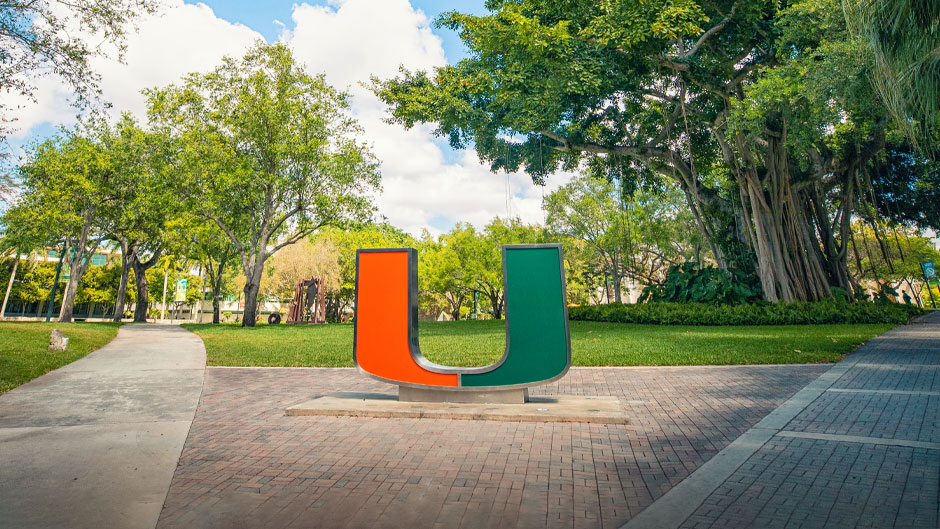Significantly improving its standing from the previous year, the University of Miami now ranks as the 49th best college in the nation, according to U.S. News & World Report’s 2021 “Best Colleges” issue, placing it back among the 50 top-tier colleges and universities.
Last fall, the University ranked 57th in the nation. Now, the University is tied with Lehigh University in Pennsylvania, Northeastern University in Boston, and Pepperdine University in California.
“This jump in the rankings reflects our commitment—even in these unprecedented times—to comprehensive excellence and selective preeminence,” said President Julio Frenk. “I am grateful for the hard work of our faculty and staff, whose devotion to our talented and diverse student body has driven improvement in key metrics like retention and graduation rates, and for the support of our ’Canes community whose generosity enables us to offer more robust financial assistance to scholars from all walks of life.”
Although they were elated to learn about the new ranking, other University leaders said these metrics are just one way to evaluate the institution.
“It’s nice to be back in the top 50,” said Jeffrey Duerk, executive vice president for academic affairs and provost. “I think that our true position in terms of national universities is higher than that, but this is just one methodology to measure universities, and it continues to highlight some important areas of progress and other areas where we know we have room for continued improvement.”
Hilarie Bass, chair of the University’s Board of Trustees, agreed, saying that she believes the University has improved throughout time, despite its variance in rankings. Still, she knows the importance of these measures to high school applicants and said that the rise in rank will elevate the reputation of the University.
“Students put weight on this ranking along with many other criteria when they are making decisions about which universities to apply to,” she said. “So, I’m very pleased that we moved up eight spaces.”
Bass also noted that the complex formula used to calculate rankings often leaves out important attributes.
“I’d like the U.S. News rankings to include some reference to diversity numbers and efforts by institutions to promote lower-income students into higher education,” she added. “In today’s world, that’s a critical component of a top-quality university.”
While this year’s rankings still consider how well institutions recruit and retain top students and faculty members, U.S. News did make some changes to its evaluation formula. For example, the media company added the new element of “student indebtedness” to its heavily weighted student outcomes category. This measures the percentage of students who graduate with debt and the amount they owe, an area in which the University has excelled in the past. The new rankings also placed less emphasis on alumni giving and student excellence, as measured by standardized test scores and high school class rank at graduation.
In recent years, many colleges have made standardized tests optional for admission, and even more— including the University of Miami—have temporarily eliminated these requirements amid the pandemic. Therefore, Dave Becher, associate provost for data governance and institutional research, expects that the student excellence category may have even less influence in next year’s rankings, which pulls data from the previous year’s test scores.
University administrators attributed this year’s higher ranking to improvements in student graduation and retention rates, a focus on keeping class sizes small, and the ability of Hurricanes to graduate with lower debt than their peers. In recent years, the University has started allocating a greater portion of its financial aid toward need-based aid, said John Haller, vice president of enrollment management.
“The University has progressively worked to increase the amount of need-based financial aid to the point where now, beginning in fall 2021, all admitted students will have their financial needs met upon admission,” Haller added.
In addition, the University’s more selective admissions process has raised the caliber of each admitted student, which also boosted the score from U.S. News.
Another factor is the higher percentage of faculty who hold a terminal degree in their teaching area. While this strength may have existed before, Becher and his staff in the Office of Institutional Research and Strategic Analytics worked with administrators across the University this year to ensure that the most current data was submitted.
Duerk is hopeful that the University’s standing will improve even more in the future, especially with the creation of the student retention task force in 2018. An initiative of the Roadmap to Our New Century, the task force of students, faculty, and staff examines ways to ensure fewer students leave before graduating and that students graduate within four years. Since data used for this year’s rankings includes graduation rates from 2010 through 2013, there is still a lag before administrators will see if their efforts moved the needle.
But Duerk still believes that students who want to attend the University of Miami will apply, regardless of the rankings.
“Students are pretty sophisticated buyers in the university marketplace,” Duerk said. “These are consumers who will get to know the programs, faculty, and value of our University in terms of establishing or achieving their future ambitions.”
In 2020, U.S. News named the University’s Bascom Palmer Eye Institute the top ophthalmology hospital in the nation for the 19th time and the Miller School of Medicine’s Department of Otolaryngology No. 28 in the nation. Last fall the University also was named 30th best college in the nation for veterans.

